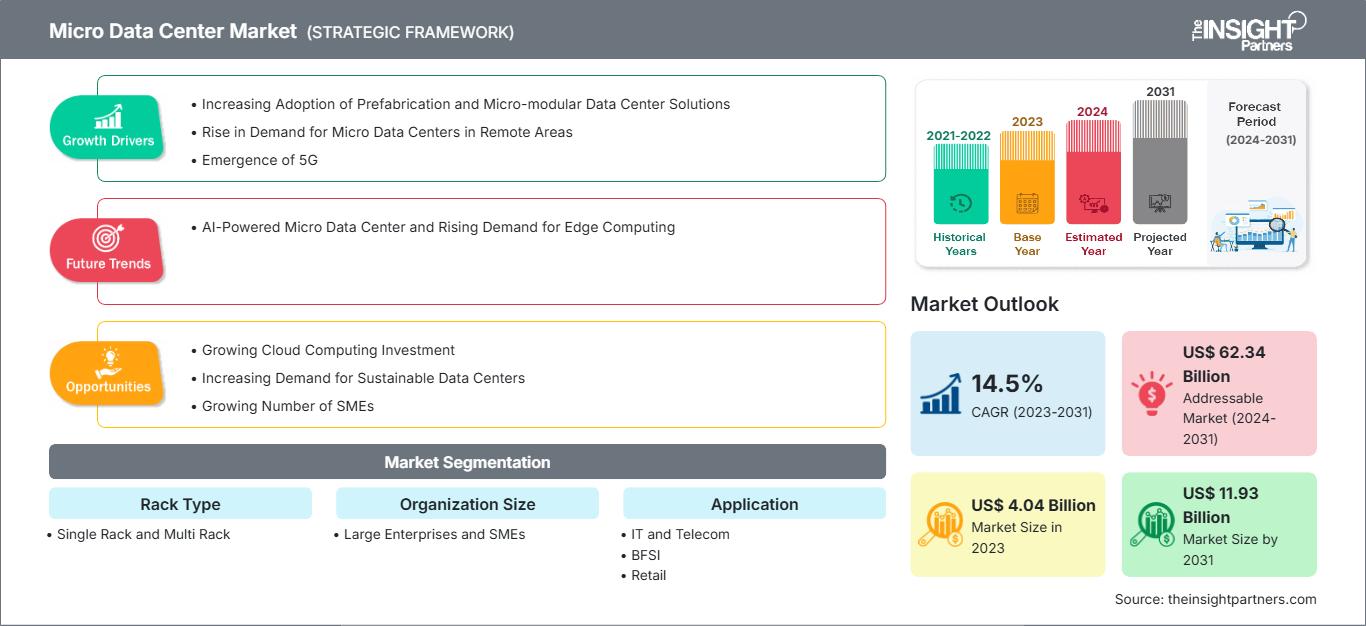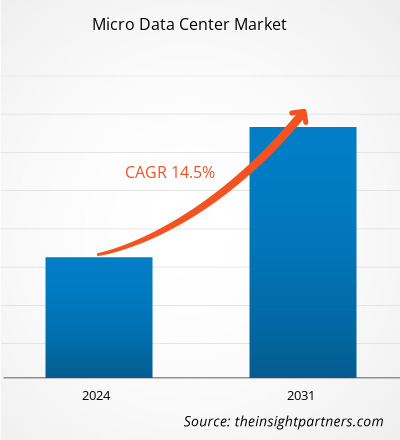微型数据中心市场规模预计将从 2023 年的 40.4 亿美元增至 2031 年的 119.3 亿美元。据估计,该市场在 2023 年至 2031 年期间的复合年增长率将达到 14.5%。人工智能驱动的微型数据中心和边缘计算需求的增长可能是关键的市场趋势。
微型数据中心市场分析
联网设备和物联网设备的使用日益增多,以及 5G 的不断推出,增加了对低延迟数据处理和存储的需求,包括偏远地区。这增加了对更多微型数据中心的需求,尤其是在偏远地区,这是推动微型数据中心市场增长的主要因素之一。此外,微型数据中心体积小巧,有助于降低冷却所需的能耗,而将其放置在数据源附近有助于最大限度地减少长距离数据传输过程中的能量损失。这可以帮助公司实现其可持续发展目标,为市场增长创造机会。北美、欧洲和中东和非洲 (MEA) 等地区的中小企业数量正在增长,预计这将在预测期内推动微型数据中心市场的增长。此外,由于边缘计算技术能够帮助实时处理和分析数据,其需求也在不断增长,从而进一步推动市场增长。
微型数据中心市场概览
微型数据中心是一种小型模块化数据中心,包含特定工作负载所需的所有计算、存储、网络、电源、冷却和其他基础设施。大多数微型数据中心包含服务器机架、网络设备、服务器和机架内冷却解决方案。通常,微型数据中心支持不超过 100 至 150 kW 的关键负载,尺寸范围从单个 19 英寸机架到 40 英尺集装箱。由于其紧凑的尺寸,它们可以安装在标准数据中心无法安装的空间中。它们是边缘应用的理想选择,尤其是在分布式、远程或无空调位置。由于整个系统都封装在一个标准 IT 机架的大小内,因此微型数据中心可以部署在现有的网络机柜或小型服务器机房、开放式办公空间、零售商店和诊所中。
自定义此报告以满足您的要求
您将免费获得任何报告的定制,包括本报告的部分内容,或国家级分析、Excel 数据包,以及为初创企业和大学提供超值优惠和折扣
微型数据中心市场: 战略洞察

- 获取本报告的主要市场趋势。这个免费样本将包括数据分析,从市场趋势到估计和预测。
您将免费获得任何报告的定制,包括本报告的部分内容,或国家级分析、Excel 数据包,以及为初创企业和大学提供超值优惠和折扣
微型数据中心市场: 战略洞察

- 获取本报告的主要市场趋势。这个免费样本将包括数据分析,从市场趋势到估计和预测。
微型数据中心市场驱动力与机遇
预制和微模块化数据中心解决方案的日益普及
预制和微模块化数据中心解决方案的日益普及,极大地推动了微型数据中心市场的增长。随着企业寻求提高运营效率和可扩展性,这些创新解决方案为传统数据中心模式提供了极具吸引力的替代方案。模块化设计支持快速部署和灵活性,使企业能够快速响应不断变化的需求并优化其基础设施。这在IT、电信和医疗保健等对高级数据处理能力需求日益增长的行业尤为重要。微型数据中心的模块化设计能够根据每个行业的独特需求进行灵活且即时的部署,从而显著增强了其在各行各业的吸引力。这种适应性意味着企业可以根据不断变化的需求快速扩展其基础设施,从而高效地管理资源,而无需像传统数据中心建设那样耗费较长的交付周期。例如,在IT行业,企业可以部署微型数据中心来支持云服务和边缘计算,从而确保最低延迟并为最终用户提升性能。同样,电信行业也受益于在战略位置快速安装模块化单元的能力,从而提升网络可靠性和容量,尤其是在5G技术推广的情况下。在数据安全和合规性至关重要的银行业,可以快速部署微型模块化数据中心,在保护敏感信息的同时,提供交易和分析所需的计算能力。随着这些行业数据中心容量的高速增长,微型数据中心的模块化特性使其成为高效、有效地支持其不断变化的基础设施需求的理想解决方案。
云计算投资不断增长
受对高效、可扩展和灵活的数据处理解决方案日益增长的需求的推动,云计算投资的不断增长有望显著推动微型数据中心市场的发展。例如,甲骨文公司于2024年6月宣布计划投资超过10亿美元在马德里建立第三个云区域,旨在加强全国范围内的人工智能技能发展。这个新的公共云区域将赋能甲骨文在西班牙各行各业的客户和合作伙伴,包括重要的金融服务业,帮助他们将关键任务工作负载从本地数据中心迁移到 Oracle 云基础设施 (OCI)。此外,该计划还将帮助企业满足重要的监管要求,例如《数字运营弹性法案》(DORA) 以及欧洲银行管理局 (EBA)、欧洲互联网运营商协会 (EIOPA) 和欧洲证券和市场管理局 (ESMA) 制定的《欧洲外包指南》。西班牙电信 (Telefónica Españildea) 已被指定为即将推出的云区域的托管合作伙伴,这将加强双方在该地区推进云能力方面的合作。随着企业持续采用云技术,微型数据中心将在满足其不断变化的基础设施需求方面发挥关键作用,最终塑造各个行业数据管理的未来。
微型数据中心市场报告细分分析
促成微型数据中心市场分析的关键细分领域包括机架类型、组织规模和应用。
- 根据机架类型,市场分为单机架和多机架。 2023 年,单机架市场占据了市场主导地位。
- 就组织规模而言,市场分为大型企业和中小型企业。2023 年,大型企业市场占据了市场主导地位。
- 根据应用,市场分为 BFSI、零售、IT 和电信、制造、医疗保健等。2023 年,IT 和电信市场占据了市场主导地位。
按地区划分的微型数据中心市场份额分析
- 微型数据中心市场分为五大区域:北美、欧洲、亚太地区 (APAC)、中东和非洲 (MEA) 以及南美和中美。2023 年,北美占据了市场主导地位,其次是欧洲和亚太地区。
- 北美的微型数据中心市场分为美国、加拿大和墨西哥。北美微型数据中心市场正在经历显著增长,这主要得益于边缘计算解决方案需求的不断增长以及 5G 基础设施的部署。美国电信公司在这一领域尤为活跃,他们战略性地将微型数据中心部署在基站和网络聚合点,以提升网络性能并降低延迟。先进的不间断电源 (UPS) 系统等创新电源解决方案的引入预计将进一步提振市场。此外,各行各业正在进行的数字化转型,加上物联网设备产生的数据量不断增长,也推动了对微型数据中心的需求。这些设施具有便携性、可扩展性和能源效率等优势,对于希望提升数据管理策略的企业来说,是一个颇具吸引力的选择。
微型数据中心市场区域洞察
The Insight Partners 的分析师已详尽阐述了预测期内影响微型数据中心市场的区域趋势和因素。本节还讨论了北美、欧洲、亚太地区、中东和非洲以及南美和中美洲的微型数据中心市场细分和地域分布。
微型数据中心市场报告范围
| 报告属性 | 细节 |
|---|---|
| 市场规模 2023 | US$ 4.04 Billion |
| 市场规模 2031 | US$ 11.93 Billion |
| 全球复合年增长率 (2023 - 2031) | 14.5% |
| 历史数据 | 2021-2022 |
| 预测期 | 2024-2031 |
| 涵盖的领域 |
By 机架类型
|
| 覆盖地区和国家 | 北美
|
| 市场领导者和主要公司简介 |
|
微型数据中心市场参与者密度:了解其对业务动态的影响
微型数据中心市场正在快速增长,这得益于终端用户需求的不断增长,而这些需求的驱动因素包括消费者偏好的不断变化、技术进步以及对产品优势的认知度不断提高。随着需求的增长,企业正在扩展其产品线,不断创新以满足消费者需求,并抓住新兴趋势,从而进一步推动市场增长。

- 获取 微型数据中心市场 主要参与者概述
微型数据中心市场新闻及最新发展
微型数据中心市场评估是通过收集一手和二手研究的定性和定量数据进行的,这些数据包括重要的公司出版物、协会数据和数据库。微型数据中心市场的一些发展如下:
- 全球关键数字基础设施和连续性解决方案提供商 Vertiv 推出了 Vertiv SmartAisle 3,这是一款微型模块化数据中心系统,利用人工智能 (AI) 的强大功能,提供增强的智能功能,并支持数据中心环境的高效运营。SmartAisle 3 现已在东南亚、澳大利亚和新西兰上市,其总 IT 负载最高可达 120kW。它适用于银行、医疗保健、政府和交通运输等众多行业应用。
(来源:Vertiv,新闻稿,2024 年 4 月)
- Rittal GmbH & Co. KG 推出了一款新产品 RiMatrix 微型数据中心。 RiMatrix 微型数据中心是紧凑、强大且功能齐全的 IT 硬件之家。Rittal RiMatrix 微型数据中心可确保 IT 设备安全封装,并实现最低的碳排放,无论其位于何处。此外,全球标准化与适应性相结合意味着这些新软件包可以更好地发挥其优势。
(来源:Rittal GmbH & Co. KG,新闻稿,2022 年 11 月)
微型数据中心市场报告覆盖范围和可交付成果
《微型数据中心市场规模和预测(2021-2031)》对市场进行了详细的分析,涵盖了以下领域:
- 涵盖范围内所有关键细分市场的全球、区域和国家/地区微型数据中心市场规模和预测
- 微型数据中心市场趋势以及市场动态,例如驱动因素、限制因素和关键机遇
- 详细的 PEST 和 SWOT 分析
- 微型数据中心市场分析,涵盖关键市场趋势、全球和区域框架、主要参与者、法规和最新市场发展
- 行业格局和竞争分析,涵盖市场集中度、热图分析、知名参与者和最新发展面向微型数据中心市场
- 详细的公司简介
- 历史分析(2 年)、基准年、预测(7 年)及复合年增长率
- PEST和SWOT分析
- 市场规模、价值/数量 - 全球、区域、国家
- 行业和竞争格局
- Excel 数据集
近期报告
相关报告
客户评价
购买理由
- 明智的决策
- 了解市场动态
- 竞争分析
- 客户洞察
- 市场预测
- 风险规避
- 战略规划
- 投资论证
- 识别新兴市场
- 优化营销策略
- 提升运营效率
- 顺应监管趋势




















 获取免费样品 - 微型数据中心市场
获取免费样品 - 微型数据中心市场